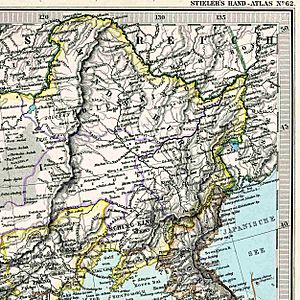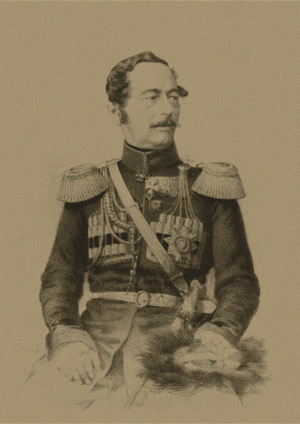Nikolay Muravyov-Amursky facts for kids
Quick facts for kids
Nikolay Muravyov-Amursky
|
|
|---|---|
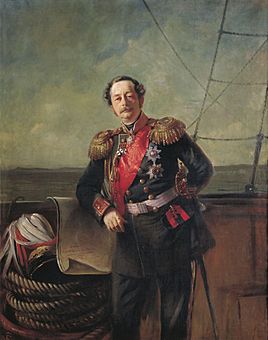
Nikolay Muravyov-Amursky (1863);
portrait by Konstantin Makovsky |
|
| Born | August 23, 1809 St. Petersburg, Russian Empire |
| Died | November 30, 1881 (aged 72) Paris, France |
| Buried | |
| Allegiance | |
| Service/ |
Imperial Russian Army |
| Years of service | 1827–1861 |
| Rank | General of the Infantry |
| Battles/wars | Caucasian War Russo-Turkish War (1828–1829) November Uprising Crimean War |
| Awards | Order of St. George Order of St. Vladimir |
Count Nikolay Nikolayevich Muravyov-Amursky (born August 23, 1809 – died November 30, 1881) was an important Russian general, politician, and diplomat. He played a big part in helping the Russian Empire expand its lands. He helped Russia gain control of the Amur River area and reach the shores of the Sea of Japan.
Contents
Nikolay Muravyov-Amursky: Early Life and Military Career
Nikolay Muravyov was born in Saint Petersburg, Russia. He finished his studies at the Page Corps in 1827. He joined the military and fought in the Russo-Turkish War, 1828–1829 (1828–1829). He also helped put down the November Uprising in Poland in 1831.
Because of his health, he left the army in 1833. He went home to take care of his family's land. But in 1838, he returned to the military. He worked as an aide-de-camp (a personal assistant to a higher-ranking officer) for General Golovin in the Caucasus region. During a fight against mountain people, Muravyov was injured.
In 1840, Muravyov was put in charge of defending part of the Black Sea coast. He helped stop a rebellion by the Ubykh people there.
Becoming a General and Governor
Muravyov became a major-general in 1841. But he had to leave the military for good due to his health. He then started working for the government's Ministry of Internal Affairs. In 1846, he became the acting military and civil governor of the Tula province. He wanted to make the province better. He suggested starting a farming society for the area.
Muravyov was the first governor to ask Tsar Nicholas I to end serfdom. Serfdom was a system where peasants were tied to the land and belonged to landowners. Nine local landowners also signed his request. The tsar didn't act on the petition. But from then on, he called Muravyov a "liberal" and a "democrat."
Nikolay Muravyov-Amursky: Governor of East Siberia
On September 5, 1847, Muravyov was made the governor-general of Irkutsk and Yeniseysk. These areas were part of Eastern Siberia. This was a big deal because he was only 38 years old. It was unusual for someone so young to be in charge of such a huge area.
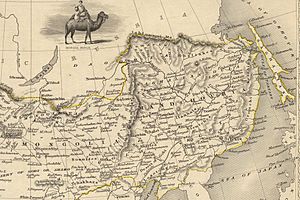
Tsar Nicholas I personally told Muravyov to try and gain an advantage over China. This was against the ideas of the Russian Foreign Minister, Karl Nesselrode. Muravyov's first step as governor-general was to stop people from stealing public money. He also made sure that native Siberian and Far Eastern students learned the Russian language in schools.
He wanted to explore and settle the lands north of the Amur River. He often used political exiles (people sent away from their home country for political reasons) to help. Many of his actions aimed to increase trade in the Far East. He also thought religion was important for controlling the local people. So, he supported building new Christian churches. He also promoted local beliefs like shamanism and Buddhism.
Expanding Russia's Borders
After the 1689 Treaty of Nerchinsk, Russia lost the right to use the Amur River for travel. Muravyov pushed for a strong policy with China. This was despite many officials in St. Petersburg being against it. They worried it would harm relations between the two countries.
However, Russia claimed the lower parts of the Amur River. So, the government approved several trips led by Gennady Nevelskoy. From 1851 to 1853, expeditions were sent to the Amur Liman (the mouth of the Amur River) and Sakhalin island. Russian settlements were then set up in these places.
On January 11, 1854, Tsar Nicholas I allowed Muravyov to talk with the Chinese. The goal was to set a border along the Amur River. He was also allowed to move troops to the Amur's mouth. From 1854 to 1858, Muravyov helped Gennady Nevelskoy achieve this.
The first expedition happened in May 1854. A group of 77 boats and rafts, led by the steamship Argun, sailed down to the Amur's mouth. Because of the Crimean War, some of the boats were sent to Kamchatka. There, artillery batteries (groups of cannons) were set up to defend the peninsula. These batteries were very important in defending the city of Petropavlovsk. The city was attacked by English and French forces during the Siege of Petropavlovsk.
The 1855 expedition brought the first Russian settlers to the Amur's mouth. Muravyov started talks with the Chinese around this time.
Nikolay Muravyov-Amursky: The Treaty of Aigun
During his last expedition in 1858, Muravyov signed the Treaty of Aigun with a Qing official named Yishan. At first, the Chinese did not want to set any borders along the Amur River. They preferred to keep the nearby lands under shared control with Russia.
However, Muravyov was able to convince the Chinese that Russia wanted peace and to build things. The Treaty of Aigun officially made the Amur River the border between Russia and the Qing Empire. It also gave Russia free access to the Pacific Ocean. Because of this, Muravyov was given the special title of Count Amursky. This means "of the Amur River."
The signing of the treaty was celebrated with big lights in Peking and parties in major Siberian cities. The new lands Russia gained included Priamurye and most of the areas of modern Primorsky and Khabarovsk krais (territories).
The Beijing Treaty of 1860 later confirmed and added to the Treaty of Aigun. This new treaty gave Russia the right to the Ussuri krai and the southern parts of Primorye.
Challenges in Settlement
As governor-general of Eastern Siberia, Muravyov-Amursky tried many times to settle people along the Amur River. Most of these attempts were not very successful. Very few people wanted to move to the Amur area on their own. Muravyov had to move several groups of Baikal Cossacks to help populate the area. Attempts to set up steamboat travel on the Amur and build a postal road also failed.
Officials in St. Petersburg were worried about taking over the left bank of the Amur. Their main concern was not having enough people to defend the new lands. Muravyov-Amursky successfully asked for Nerchinsk peasants to be freed from forced work in the ore mines. With these people, a group of 12,000 Amur Cossacks was formed. They were used to settle some of the lands. The main part of this military group were Cossacks moved from the Transbaikalia region.
Muravyov-Amursky retired from his governor-general job in 1861. This happened after his idea to divide Eastern Siberia into two separate governor-general areas was turned down. He was then made a member of the State Council. In 1868, he moved to Paris, France. He lived there until he died in 1881. He only visited Russia sometimes to attend State Council meetings.
Nikolay Muravyov-Amursky: Commemorations
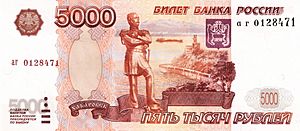
In 1891, a bronze statue of Muravyov was put up on a cliff near the Amur River in Khabarovsk. In 1929, it was taken down and replaced with a statue of Lenin. The Lenin statue stayed there until 1989. The Muravyov-Amursky memorial was put back in 1993.
In 1992, Muravyov-Amursky's remains were brought from Paris. They were re-buried in the center of Vladivostok. The city stands on the Muravyov-Amursky Peninsula, which is named after him. In 2012, a bronze statue of the governor was placed over his tomb. It looks out over the Zolotoy Rog bay, which he visited in the 1850s.
The Khabarovsk monument, along with the Khabarovsk Bridge over the Amur River, is shown on the 5000 ruble banknote. This banknote was issued by the Central Bank of the Russian Federation on July 31, 2006.
See also
 In Spanish: Nikolái Muraviov-Amurski para niños
In Spanish: Nikolái Muraviov-Amurski para niños
- Amur Annexation


